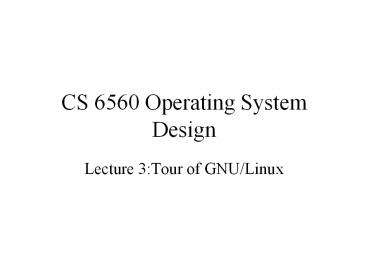CS 6560 Operating System Design PowerPoint PPT Presentation
1 / 17
Title: CS 6560 Operating System Design
1
CS 6560 Operating System Design
- Lecture 3Tour of GNU/Linux
2
More on Kernel Compiling
- Configuration
- make defconfig
- make menuconf
- Looking at .conf
- Making the initrd
- Documentation on initrd and mkinitrd
- Dealing with incompatibilities
3
Some references
- An introduction to Linux
- http//tldp.org/LDP/intro-linux/html/
- An introduction to the Bash shell
- http//tldp.org/LDP/Bash-Beginners-Guide/html/inde
x.html
4
Tour of Linux
- Accounts
- Logging in and out
- Getting help
- Shells bash
- Common commands
- Editors
- Compiler gcc
- Make
- Services
5
Getting Help
- man
- info
- Documents directory of the source
6
Shells
- Why have shells?
- Giving commands (requests) to the system
- What is a shell?
- Command interpreter
- Basic commands internal and external
- Internal
- Control structures (if, while, for, break,
continue, exit) - Job control (fg, jobs)
- Current status (cd, pwd, )
- I/O (read, echo, printf)
- External loaded into new process
- What shells are available?
- sh, csh, tcsh, zsh, bash, rc, etc.
7
Bash Shell Syntax
- See info bash
- Everything is broken into words first
- Shell variables
- variables are stored as strings
- variables can be assigned values
- use of to get value
- export shell -gt environmental variable
- Parameters
- 1, 2,
- set, unset, shift
- Quoting and expanding
- Several types of expansions
- Brace Expansion Expansion of expressions within
braces. - Tilde Expansion Expansion of the character.
- Shell Parameter Expansion Expansion of
variables to their values. - Command Substitution Using the output of a
command as an argument. - Arithmetic Expansion Using arithmetic in shell
expansions. - Filename Expansion wild cards and square
brackets - single and double quotes, escaping with backslash
8
The Shell as a programming environment
- Creating a script
- ! notation
- Executing the script
- sourcing with . or source
- invoking by name (must set the permissions)
9
External Commands
- File and directory manipulation
- cp, rm, chmod, mkdir, rmdir, ls
- Filters
- grep, sort, cat, head, tail, cut, paste, od, tr,
pr, wc - Program development
- Gcc, make
- Text processing
- System administration
10
Some Common External Commandsfile and directory
manipulation
ls List directory entries
cd Change directory
pwd Print path of current directory
chmod Change permissions
mkdir Create a new directory
rmdir Remove a directory
mv Move a directory entry
rm Remove a directory entry
11
Some Common External Commands text manipulation
(filters)
cat Concatenate multiple files to standard output
more Paged output to standard output
less Fancier version of more
head Show the first few lines of a file
tail Show the last few lines of a file
grep Search files for a pattern
cut Cut columns of text from a file
od Octal dump a file (also hex,char,binary)
sort Sort a file
tr Translate a file character by character
pr Format a file for printing
wc Count words, lines, characters
12
Unix Permissions
- Each file and directory has an owner and a group
membership - Permissions are organized by user (owner), group,
and others - u user, g group, o others
- Permissions consists of read, write, and execute
for each type of user - r read, w write, x execute
- Permissions can be viewed with the ls command and
changed with the chmod command. - Permissions meanings are different for regular
files than for directories (see man page for ls
and chmod). - Examples in class
13
Editors
- vi (now vim)
- emacs
- pico
14
Getting Organized
- Use permissions for privacy
- Organize your work in directories
15
Program Development
- Shells
- Perl
- C gcc
- Use of make (see info make)
16
The proc file system
- Shows a view of the kernel in terms of files
- For details see
- man proc
- /usr/src/linux/Documentation/filesystems/proc.txt
- Assignment 2 - using proc to get information
about a machine
17
Services
- Many processes run in the background taking care
of things such as printing and logging people in. - Vmware-tools is an example service.
- Centos has a GUI interface to its service through
the system configuration menu. - Services can be controlled directly from command
lines and scripts located in /etc/init.d and
referenced from /etc/rc.d according to runtime
level. - see the scripts for vmware-tools

